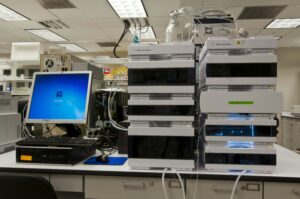
Researchers at the University of Rochester have developed groundbreaking algorithms that illuminate the atomic-level processes transforming propane into propylene, a crucial step in producing everyday items such as plastic bottles and outdoor furniture. This advancement, detailed in a recent study published in the Journal of the American Chemical Society, offers potential for significant improvements in industrial chemical production.
The announcement comes as industries strive to enhance efficiency and reduce costs. A 2021 study in Science revealed that tandem nanoscale catalysts could consolidate multiple reaction steps into a single process, promising increased yields and cost savings. However, the atomic intricacies of these reactions remained elusive, hindering broader application across various industrial processes.
Decoding the Atomic Puzzle
The University of Rochester team, led by Assistant Professor Siddharth Deshpande from the Department of Chemical and Sustainability Engineering, has successfully developed algorithms that identify the critical atomic features driving the complex chemistry involved in converting propane to propylene. These insights are particularly significant given the involvement of materials in multiple states during the reaction.
“There are so many different possibilities of what’s happening at the catalytic active sites, so we need an algorithmic approach to very easily yet logically screen through the large amount of possibilities that exist and focus on the most important ones,” Deshpande explained. “We refined our algorithms and used them to do a very detailed analysis of the metallic phase and oxide phase driving this very complex reaction.”
Unexpected Discoveries
Deshpande, along with PhD student Snehitha Srirangam, uncovered surprising details in their analysis. The oxide in the reaction showed a preference for growing around defective metal sites selectively, a factor crucial for the catalyst’s stability. Interestingly, despite existing under various chemical compositions, the oxide consistently maintained its role near these defective sites.
According to Deshpande, these findings could revolutionize the understanding of other chemical reactions, such as methanol synthesis, which is pivotal for producing paints and fuel cells. By applying their algorithmic approach, researchers can potentially unlock more efficient production methods, moving beyond traditional trial-and-error techniques.
Implications for Industrial Chemistry
The move represents a significant shift in how companies might approach chemical production. By leveraging these insights, industries could strategically enhance the efficiency of propylene and other industrial material production processes. Deshpande believes this approach could open new avenues for understanding long-standing chemical enigmas.
“Our approach is very general and can open the doors to understand many of these processes that have remained an enigma for decades,” Deshpande stated. “We know these processes work, and we produce tons of these chemicals, but we have much to learn about why exactly they’re working.”
This development follows a broader trend in the scientific community toward utilizing advanced computational techniques to solve complex chemical puzzles. As industries increasingly seek sustainable and cost-effective production methods, such innovations are likely to play a pivotal role in shaping the future of chemical manufacturing.
Looking Ahead
As the research community continues to explore these atomic-level insights, the potential for transformative changes in industrial chemistry grows. The University of Rochester’s algorithms not only provide a deeper understanding of existing processes but also pave the way for innovations that could redefine production strategies across various sectors.
Meanwhile, companies are encouraged to adopt these advanced methodologies to not only enhance efficiency but also contribute to a more sustainable industrial landscape. The ongoing research and its applications underscore the critical importance of bridging the gap between theoretical chemistry and practical industrial applications.
In conclusion, as the chemical industry grapples with the challenges of modern production demands, the insights from the University of Rochester offer a promising path forward. By embracing these algorithmic advancements, industries can look toward a future of more efficient, cost-effective, and sustainable chemical production.






